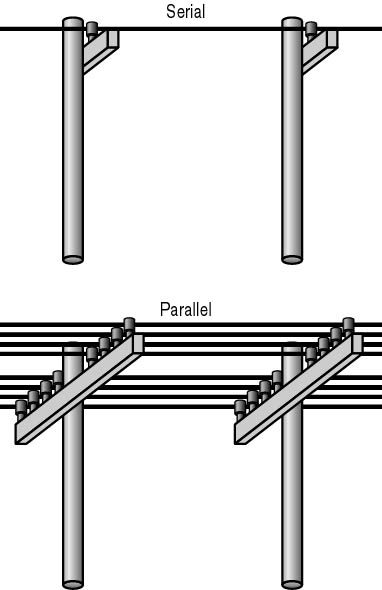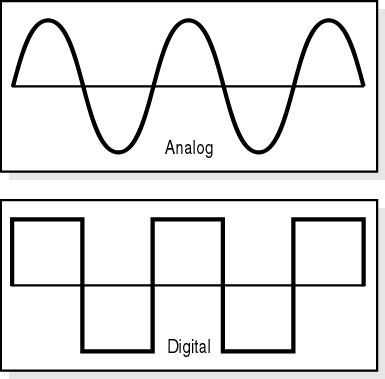The reverse is to demodulate, to remove the fixed signal and have the superimposed code remain. For many years, this has been an effective way to communicate over long distances, using both wires and radio waves.
The following table defines some basic terms used with modem communication.
| Term | Definition |
|---|---|
| Baud rate | The number of events, or signal changes, that occur in one second. It was used as an early measurement of how fast a modem can send data, because at that time, modems transmitted data at a speed equal to the baud rate (one bit per cycle). Today's high-speed modems use complex signals to send more data; therefore, data transfer can exceed baud rate. The baud rate is limited by the capability of copper wires to transmit signals. |
| bps | Stands for bits per second-the speed at which a modem transmits data. Typical rates are 14,400; 28,800; 33,600; and 56,600 bps. These numbers represent the actual number of data bits that can be transmitted per second. |
| Browser | Software used to explore sites on the World Wide Web using the HyperText Transfer Protocol (HTTP). |
| Bulletin board service (BBS) | Interactive software that offers the ability log directly onto a remote computer to post and retrieve messages, and to upload and download files. Some BBSs offer the opportunity to chat live with other members who are online at the same time. The Internet has diminished the importance of BBS software. |
| Download | The act of transferring a file from a remote computer (host) to a local computer (client). When downloading, you are receiving a file. |
| DTMF | Stands for dual-tone multifrequency, the technology behind the tones of a touchtone phone. |
| Internet | A worldwide, online network that links computers by means of the TCP/IP protocol. (See entry for TCP/IP later in this table.) |
| Internet server | A computer/software combination that provides a gateway and supporting services for linking other computers to the Internet. |
| IP | Stands for Internet Protocol-the network protocols used to define how data is transmitted on the Internet. |
| IP address | Stands for Internet Protocol address-a unique, 32-bit address that identifies every network and host on the Internet. (A host is the TCP/IP network interface within the computer, not the computer itself; a computer with more than one network interface card-NIC-can have more than one IP address, one for each card.) |
| ISDN | Stands for Integrated Services Digital Network, a digital telephone connection like a modem that uses digital links and offers speeds about five times that of an analog modem. The ISDN system is a packet system that can also handle voice communication. |
| ISP | Stands for Internet service provider-a host computer that you can dial into over a modem to connect to the Internet. |
| Logging on | The process of sending the appropriate signals and gaining access to a remote computer over a modem or other remote connection. |
| Modem | A device for converting a computer's digital data stream to and from an analog form so that it can be sent over a telephone line. |
| Offline | Status of a computer that is not connected to another device over a modem or other telecommunications device. |
| Offline reader | A program designed to display e-mail messages or other information that has been downloaded to one computer from another. |
| Online | An active connection between two computers, making possible the exchange of data. |
| POTS | Stands for Plain Old Telephone Service, a common term that denotes the basic analog phone network as compared to newer digital networks used for packet transfer of data. |
| Protocol | A set of rules that govern the transfer and verification of data between two or more systems. |
| Proxy server | A computer/modem/software combination that manages Internet traffic to and from a local area network (LAN) and can provide other features, such as document caching and access control. |
| Settings (modem) | Configuration required by the telecommunications software in order for data to be transmitted. Usually 8 bits, no parity, 1 stop bit (8N1) will work. Some BBSs require special terminal emulation, a software configuration that mimics the operation of proprietary mainframe terminals like the VT100. |
| Sysop | The system operator of a BBS (pronounced SIS-op). |
| TCP/IP | Stands for Transmission Control Protocol/Internet Protocol-the name given to a collection of protocols that were designed in the 1970s for use on the large-scale, mixed-platform environment that became the Internet. |
| Telecommunications | The ability to transmit data over telephone lines to a remote computer. Often abbreviated as "telecom." |
| Telecommunications software | An application that allows two computers to communicate with each other. Both computers must use compatible software for communication to take place. |
| Upload | The ability to transfer a file from a local computer to a remote computer. When uploading, you are sending a file to another computer. |
| Webmaster | A person who manages a Web site on the Internet's World Wide Web. The Webmaster's duties are analogous to those of a BBS. |
Communication
Two basic problems arise from using modems to transmit data. The first problem is that, as we saw in Tutorial 4, computers transfer data using 8, 16, or 32 parallel wires or buses, while telephone systems use only two wires. (See Figure 12.4)

Figure 12.4 Serial and parallel communication
The second problem is that telephone and radio systems use analog signals (based on waveforms), and computers use digital signals, either on or off, as shown in Figure 12.5.

Figure 12.5 Analog and digital signals
A modem resolves both of these problems by acting as an analog-to-digital (A/D) converter as well as a modulator/demodulator.